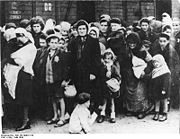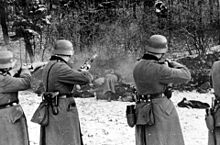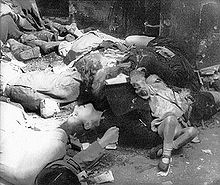- Nazi crimes against ethnic Poles
-
In addition to about 2.9 million Polish Jews (mostly killed in Operation Reinhard), about 2.8 million non-Jewish Polish citizens perished during the course of the war.[1][2] Two million were ethnic Poles, the remaining 500,000 were mainly ethnic minority Ukrainians and Belarusians living in Poland.
The majority of those killed by Nazi Germany were civilians (exceeding military deaths nearly 10:1).[3][4]
From the start of the war against Poland, Germany intended to realize the plan laid-out by the Nazi leader Adolf Hitler in his 1926 book Mein Kampf. The aim of this plan was to turn Eastern Europe into part of greater Germany, the so-called German Lebensraum ("living space"). Nazi ideology had viewed Slavs as a racially inferior group.[5] On August 22, 1939, on the invasion of Poland, Hitler gave explicit permission to his commanders to kill "without pity or mercy, men, women, and children of Polish descent or language".[6] Genocide was conducted systematically against Polish people: on September 7, 1939 Reinhard Heydrich stated that all Polish nobles, clergy and Jews are to be killed, on September 12 Wilhelm Keitel added intelligentsia to the list, at the end of 1940 Hitler demanded liquidation of "all leading elements in Poland" and on March 15, 1940, Himmler stated All Polish specialists will be exploited in our military-industrial complex. Later, all Poles will disappear from this world. It is imperative that the great German nation considers the elimination of all Polish people as its chief task.[7]
1939 September Campaign
Main article: Invasion of Poland (1939)About 150,000 to 200,000 Polish civilians were killed during the one-month September Campaign,[8] characterized by the indiscriminate and often deliberate targeting of civilians by the invading forces of Nazi Germany[9] and the Soviet Union.[10] Many of the them were killed in the Luftwaffe's terror bombing operations (including the bombing of Frampol[11] and Wieluń,[12]). Massive air raids were conducted on these, and other towns which had no military infrastructure.[13] Columns of fleeing refugees were systematically attacked by the German fighter and dive-bomber aircraft.[14]
From the first day of the war, the round-ups and summary executions of Poles commenced by Wehrmacht, SS and Selbstschutz. Several thousand Polish POWs were also murdered.[15]
Einsatzgruppen killings
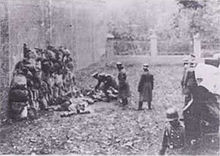 Execution of Poles by Einsatzkommando - Leszno, October 1939
Execution of Poles by Einsatzkommando - Leszno, October 1939 Main article: EinsatzgruppenSee also: Operation Tannenberg, German AB-Aktion operation in Poland, and Intelligenzaktion
Main article: EinsatzgruppenSee also: Operation Tannenberg, German AB-Aktion operation in Poland, and IntelligenzaktionDuring the 1939 German invasion of Poland, "special action squads" of the SS and police (the Einsatzgruppen) were deployed behind the front lines, arresting and killing civilians considered, by virtue of their social status, to be capable of abetting resistance efforts against the Germans.[16][17]
Soon after the German invasion of Poland, lasting from fall of 1939 till spring of 1940 in first action of mass killings known as Intelligenzaktion, tens of thousands of former government officials, military officers in hiding, landowners, clergy, and members of the intelligentsia according to the "enemies lists" - Sonderfahndungsbuch Polen. Action was a part of Operation Tannenberg - early measure of the Generalplan Ost. Poles as well as Jews were either murdered in mass executions by death squads or sent to prisons and concentration camps. "Whatever we find in the shape of an upper class in Poland will be liquidated,[18]" Hitler had ordered.[19] Only in Intelligenzaktion Pommern – regional action in Pomeranian Voivodeship was killed 23 000 of Poles,[20] It was continued by the German AB-Aktion operation in Poland.[21] In the mid-1940s, the AB-Aktion saw several thousand more killed or imprisoned (including the massacre of Lwów professors and the executions in Palmiry forest). The Einsatzgruppen were also responsible for the murder of Jews and Poles during the German invasion of the Soviet Union.[22]
Terror and pacification operations
During the occupation, communities were held collectively responsible for Polish attacks against German troops and mass executions were conducted in reprisal.[23] In the area in and around Bydgoszcz, about 10,000 non-Jewish Polish civilians were murdered in the first four months of the occupation (see Bloody Sunday).[24] German army and paramilitary units composed of Volksdeutsche also participated in executions of civilians.[25]
The Nazis took hostages by the thousands at the time of the invasion and all during their occupation of Poland.[24][26] Hostages were selected from among the most prominent citizens of occupied cities and villages: priests, professors, doctors, lawyers, as well as leaders of economic and social organizations and the trade unions. Often, however, they were chosen at random from all segments of society and for every German killed a group of between 50 and 100 Polish civilians were executed.[24] About 20,000 villagers, some of whom were burned alive, were killed in large-scale punitive operations targeting the rural settlements suspected of aiding the resistance or hiding Jews and other fugitives.[27] Seventy-five villages were razed in these operations. Poland was the only country in occupied Europe where the penalty for hiding a Jew was death for everyone living in the house; other laws were similarly ruthless.
Cultural genocide
Main article: Polish culture during World War IIAs part of the plan to destroy Poland, the Germans engaged in cultural genocide in which they destroyed or closed universities and high schools, libraries, museums and national monuments as well as scientific institutes and laboratories.[28] Millions of books were destroyed, including an estimated 80% of all school libraries, and three-quarters of all scientific libraries.[29] Polish children were forbidden from acquiring education beyond the elementary level so that a new generation of Polish leaders could not arise in the future.[28] According to a May, 1940, memo from Heinrich Himmler: "The sole goal of this schooling is to teach them simple arithmetic, nothing above the number 500; writing one's name; and the doctrine that it is divine law to obey the Germans. I do not think that reading is desirable."[28] By 1941, the number of children attending elementary school in the General Government was half of the pre-war number.[30]
The Poles responded with the "Secret Teaching" (Tajne Nauczanie) a campaign of underground education.
Sexual slavery
While mass rapes were committed by German forces on Jewish women and girls, beginning with the Invasion of Poland in September 1939;[31] they were also committed en masse against non-Jewish Polish women and girls, including during mass executions of ethnic Polish citizens, when rapes were carried-out before shooting the women.[32] Additionally, large numbers of Polish women were captured with the aim of forcing them into serving in German military brothels.[33] Mass raids were reported, made by Nazi forces in Polish cities with the express aim of capturing young women, who later were forced to work in brothels attended by German soldiers and officers.[33] Girls as young as 15 years old, who were ostensibly classified as "suitable for agricultural work in Germany", were forced to work as prostitutes for German soldiers at their place of destination.[33]
Plans for the "final solution"
Main article: Generalplan OstIn the same document, Himmler promised to eventually deport all Slavic Poles to Russia. In other statements, he mentioned the future killing fields in the Pripet Marshes where all were intended to die during the cultivation of the swamps. Plans for the mass transportation and creation of slave labor camps for up to 20 million Poles were made. According to Himmler, "All Poles will disappear from the world. [...] It is essential that the great German people should consider it as its major task to destroy all Poles."[6]
Expulsion of Polish population
Main articles: Expulsion of Poles by Germany and World War II evacuation and expulsionGermany planned to completely remove the indigenous population of Poland. According to the Lebensraum ideology, their place was to be taken by the German military and civilian settlers. During the occupation, more than one million Poles were expelled by German authorities,[34] including 923,000 Poles ethnically cleansed from territories Germany annexed into the Reich.[35]
These expulsions were carried out so abruptly that ethnic Germans being resettled in the homes with half-eaten meals on tables and unmade beds where small children had been sleeping at the time of expulsion.[36] Members of Hitler Youth and the League of German Girls were assigned the task of overseeing such evictions to ensure that the Poles left behind most of their belongings for the use of the settlers.[37]
Concentration camps
 A łapanka in Warsaw in 1941.
A łapanka in Warsaw in 1941. Main article: Nazi concentration camps
Main article: Nazi concentration campsHundreds of thousands of Poles were prisoners in the extensive concentration camp system in German-occupied Poland and the Reich. An estimated 30,000 Poles died at Mauthausen-Gusen; 150 000 at Auschwitz, 20,000 each at Sachsenhausen and Gross-Rosen; 17,000 at Neuengamme and 10,000 at Dachau. About 17,000 Polish women died at Ravensbrück. A major concentration camp complex at Stutthof, east of Gdańsk, existed from September 2, 1939, to the end of the war, where an estimated 20,000 Poles died. Many Poles died in Majdanek concentration camp in Lublin. In addition, tens of thousands of Polish people were executed or found their deaths in the dozens of other camps, prisons and other places of detention inside and outside Poland. There were even special camps for children such as the Potulice concentration camp. According to some modern research, in the years 1943–1944, the Warsaw concentration camp was used as a death camp in an attempt to depopulate the Polish capital Warsaw.
Auschwitz became the main concentration camp for Poles on June 14, 1940. By March 1941, 10,900 prisoners were registered at the camp, most of them Poles. In September 1941, 200 ailing prisoners, most of them Poles, along with 650 Soviet POWs, were killed in the first Zyklon-B gassing experiments. Beginning in 1942, Auschwitz's prisoner population became much more diverse, as Jews and other "enemies of the state" from all over German-occupied Europe were deported to the expanding camp. Franciszek Piper, the chief historian of Auschwitz, estimates that 140,000 to 150,000 Poles were brought to that camp between 1940 and 1945, and that 70,000 to 75,000 died there as victims of executions, human experimentation, starvation and disease.
Indiscriminate executions
 Public execution near Płaszów-Prokocim train station on June 26, 1942. (Krakow)
Public execution near Płaszów-Prokocim train station on June 26, 1942. (Krakow)
Non-Jewish ethnic Poles in Poland were targeted by the łapanka policy which German forces utilized to indiscriminately round up civilians off the street. In Warsaw, between 1942 and 1944, there were approximately 400 daily victims of łapanka. It is estimated that tens of thousands of these victims were killed in mass executions, including an estimated 37,000 people at the Pawiak prison complex run by the Gestapo, and thousands of others killed in the ruins of the Warsaw Ghetto.
Extermination of hospital patients
Main article: Action T4In July 1939, a Nazi secret program called Action T4 was implemented whose purpose was to effect the extermination of psychiatric patients. During the German invasion of Poland, the program was put into practice on a massive scale in the occupied Polish territories. Typically, all patients, accompanied by soldiers from special SS detachments, were transported by trucks to the extermination sites. The first action of this type took place on September 22, 1939, at a large psychiatric hospital in Kocborowo (Gdańsk region). The total number of psychiatric patients murdered by the Nazis in occupied Poland between 1939–1945 is estimated to be more than 16,000. An additional 10,000 patients died of malnutrition. Approximately 100 of the 243 members of the Polish Psychiatric Association met the same fate as their patients.
Beyond execution by firing squad, more heinous methods of mass murder were also employed. In October 1939, 1,000 patients of a psychiatric hospital in Owińska were transported to a military fortress in Poznań; there, in the bunkers of Fort VII, children as well as adults were gassed with carbon monoxide. Other Owińska hospital patients were gassed in sealed trucks using carbon monoxide from the exhaust fumes of vehicles. The same method was utilized in the Kochanówek hospital near Łódź, where 2,200 persons were killed in 1940. This was the first "successful" test of the mass murder of prisoners using poison gas. This technique was later perfected on many other psychiatric patients in Poland and Germany; starting in 1941, the technique was widely employed in the extermination camps. Nazi gas vans were also first used in 1940 to kill Polish mentally ill children.[38]
In 1943, the SS and Police Leader in Poland, Wilhelm Koppe, ordered more than 30,000 Polish patients suffering from tuberculosis to be executed. They were killed mostly in Chelmno extermination camp.
Forced labor in Germany
 Łapanka - captured civilians on the streets in Warsaw
Łapanka - captured civilians on the streets in Warsaw Main article: Forced labor in Germany during World War IISee also: Forced prostitution in German armed forces
Main article: Forced labor in Germany during World War IISee also: Forced prostitution in German armed forcesBetween 1939 and 1945, at least 1.5 million Polish citizens were transported to the Reich into forced labor, many of them teenage boys and girls. Although Germany also used forced laborers from Western Europe, Poles and other Eastern Europeans who were viewed as racially inferior were subjected to intensified discriminatory measures. They were forced to wear identifying purple tags with "P"s sewn to their clothing, subjected to a curfew, and banned from public transportation. While the treatment of factory workers or farm hands often varied depending on the individual employer, most Polish laborers were compelled to work longer hours for lower wages than Western Europeans. In many cities, they were forced to live in segregated barracks behind barbed wire. Social relations with Germans outside work were forbidden, and sexual relations ("racial defilement") were considered a capital crime punishable by death.
Germanization
See also: GermanizationIn Reichsgau Wartheland, the annexed territories of Greater Poland, the Nazis' goal was complete Germanization: assimilation politically, culturally, socially, and economically into the German Reich.[39] This did not mean old style of Germanization—Germanizing the inhabitants by teaching them the language and culture—but settling them with Germans, which would include only a small fraction of those living there, as most were not ethnical German.[40]
Germans closed elementary schools where Polish was the language of instruction.[41] Streets and cities were renamed (Łódź became Litzmannstadt, etc).[42][43] Tens of thousands of Polish enterprises, from large industrial firms to small shops, were seized from their owners.[44] Signs posted in front of those establishments warned: "Entrance forbidden for Poles, Jews, and dogs."[45] The Nazi regime was less stringent in their treatment of the Kashubians in the Reichsgau Danzig-West Prussia. Everywhere, however, many thousands of people were forced to sign the Deutsche Volksliste a racial documentation which the Nazis used to identify and give priority to people of German heritage in occupied countries.[46]
Crimes against children
At least 20,000 children in occupied Poland were also kidnapped by the Nazis to be subjected to German indoctrination.[47] These children were screened for "racially valuable traits"[48] and sent to special homes to be Germanized.[49] They were then placed for adoption if the Germanization was effective. Many of them, found by Allied forces after the war, had been utterly convinced that they were German.[50]
Children of forced workers were mistreated in Ausländerkinder-Pflegestätte, where thousands of them died.[51] A camp for children and teenagers Polen-Jugendverwahrlager der Sicherheitspolizei in Litzmannstadt worked 1943-1944 in Łódź.
Persecution of Catholic clergy
The Roman Catholic Church was suppressed in the annexed territory of Reichsgau Wartheland more harshly than elsewhere.[52] Churches were systematically closed, and most priests were either killed, imprisoned, or deported to the General Government.[52] The Germans also closed seminaries and convents persecuting monks and nuns throughout Poland.[3] In Pomerania, all but 20 of the 650 priests were shot or sent to concentration camps. Between 1939 and 1945, 2,935 members[53] of the Polish clergy (18%[54]) were killed in concentration camps. In the city of Wrocław (Breslau), 49% of its Catholic priests were killed; in Chełmno, 48%. One hundred and eight of them are regarded as blessed martyrs. Among them, Maximilian Kolbe was canonized as a saint.
1944 destruction of Warsaw
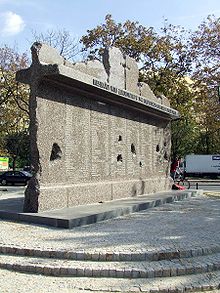 Memorial to the Wola massacre
Memorial to the Wola massacre Main article: Warsaw Uprising
Main article: Warsaw UprisingDuring the suppression of the 1944 Uprising in Warsaw, German forces committed many atrocities against Polish civilians, following the order by Hitler to level the city. The most notorious occurrence took place in Wola district where, at the beginning of August 1944, at least 40,000 civilians (men, women, and children) were methodically rounded-up and executed by the Einsatzkommando of the Sicherheitspolizei under Heinz Reinefarth's command and the amnestied German criminals from Dirlewanger. Other similar massacres took place in the areas of Śródmieście (City Centre), Stare Miasto (Old Town) and Marymont districts. In Ochota district, an orgy of civilian killings, rape and looting was carried out by Russian collaborators of RONA. After the fall of Stare Miasto, during the beginning of September, 7,000 seriously wounded hospital patients were executed or burnt alive, often with the medical staff caring for them. Similar atrocities took place later in the Czerniaków district and after the fall of Powiśle and Mokotów districts.
Between 150,000 and 180,000 civilians, and thousands of captured insurgents, were killed in the suppression of the uprising. Until the end of September 1944, Polish resistance fighters were not considered by Germans as combatants; thus, when captured, they were summarily executed. One hundred sixty-five thousand surviving civilians were sent to labour camps, and 50,000 were shipped to concentration camps,[55] while the ruined city was systematically demolished. Neither Reinefarth nor Erich von dem Bach-Zelewski were ever tried for their crimes committed during the suppression of the uprising. (The Polish request for extradition of amnestied Wilhelm Koppe from Germany was also refused.)
See also
- Anti-Polish sentiment
- Białystok Ghetto Uprising
- Consequences of German Nazism
- Częstochowa Ghetto Uprising
- Genocide
- German military brothels in World War II
- Gestapo-NKVD Conferences
- Ghetto Litzmannstadt
- Hans Frank
- Holocaust in Poland
- Holocaust victims
- Friedrich Krüger
- Kraków Ghetto
- Kielce pogrom
- Łapanka
- Medallions by Zofia Nałkowska
- Polish areas annexed by Nazi Germany
- Polish decrees
- Polish resistance movement in World War II
- Polish Underground State
- Racial policy of Nazi Germany
- Sexual Slavery by Germany during World War II
- Soviet repressions of Polish citizens (1939-1946)
- Special Prosecution Book-Poland (German: Sonderfahndungsbuch Polen)
- Territorial changes of Poland
- Valley of Death (Bydgoszcz)
- War rape by German forces during World War II
- Zhetel Ghetto
References
- ^ AFP/Expatica, Polish experts lower nation's WWII death toll, expatica.com, 30 August 2009
- ^ Polska 1939–1945. Straty osobowe i ofiary represji pod dwiema okupacjami, ed. Tomasz Szarota and Wojciech Materski, Warszawa, IPN 2009, ISBN 978-83-7629-067-6 (Introduction reproduced here)
- ^ a b Piotrowski, Tadeusz (2005). "Project InPosterum: Poland WWII Casualties". http://www.projectinposterum.org/docs/poland_WWII_casualties.htm. Retrieved 2007-03-15.
- ^ Łuczak, Czesław (1994). "Szanse i trudności bilansu demograficznego Polski w latach 1939–1945". Dzieje Najnowsze (1994/2).
- ^ The Czechs under Nazi rule: the failure of national resistance, 1939-1942, Vojtěch Mastný, Columbia University Press
- ^ a b Holocaust Forgotten - Six Million Polish Citizens Were Killed During the Holocaust
- ^ Poland's Holocaust: Ethnic Strife, Collaboration with Occupying Forces and Genocide in the Second Republic, 1918-1947 page 23 by Tadeusz Piotrowski Publisher: McFarland & Company 2007
- ^ Poland's Holocaust: Ethnic Strife, Collaboration with Occupying Forces and Genocide in the Second Republic, 1918-1947 Tadeusz Piotrowski page 301 McFarland, 1998
- ^ Martin Shaw, "War and genocide: organized killing in modern society", Wiley-Blackwell, 2003, pg. 79, [1]
- ^ Robert Gellately, "Lenin, Stalin, and Hitler: The Age of Social Catastrophe", Random House Inc, 2008, pg. 3
- ^ Europe at War 1939-1945: No Simple Victory - page 297, Norman Davies, 2006
- ^ Trenkner, Joachim (2008-08-29) (in Polish). Wieluń, czwarta czterdzieści. Tygodnik Powszechny. http://tygodnik.onet.pl/35,0,14103,2,artykul.html
- ^ Bruno Coppieters, N. Fotion, eds. (2002) Moral constraints on war: principles and cases, Lexington Books, p 74.
- ^ Hempel, Andrew. (2000). Poland in World War II: An Illustrated Military History ISBN 9780781807586 p 14.
- ^ Samuel Totten, William S. Parsons, "A Century of Genocide: Critical Essays and Eyewitness Accounts", Taylor & Francis, 2008, pg. 105, [2]
- ^ [3]
- ^ David Crowe, "Oskar Schindler: The Untold Account of His Life, Wartime Activities, and the True Story Behind the List", Basic Books, 2007, pg. 71, [4]
- ^ Geoffrey P. Megargee, "War of annihilation: combat and genocide on the Eastern Front, 1941", Rowman & Littlefield, 2007, pg. 14
- ^ Tasks of Einsatzgruppen in Poland
- ^ *Maria Wardzyńska "Był rok 1939 Operacja niemieckiej policji bezpieczeństwa w Polsce. Intelligenzaktion" IPN Instytut Pamięci Narodowej, 2009 ISBN 978-83-7629-063-8
- ^ Tadeusz Piotrowski, "Poland's holocaust: ethnic strife, collaboration with occupying forces and genocide in the Second Republic, 1918-1947", McFarland, 1998, pg. 25
- ^ Ronald Headland, "Messages of murder: a study of the reports of the Einsatzgruppen of the Security Police and the Security Service, 1941-1943", Fairleigh Dickinson Univ Press, 1992, pg. 94, [5]
- ^ Marek Jan Chodakiewicz, "Between Nazis and Soviets: occupation politics in Poland, 1939-1947", Lexington Books, 2004, pgs. 92, 105, 118, and 325
- ^ a b c Rudolph J. Rummel, "Democide: Nazi genocide and mass murder", Transaction Publishers, 1992, pg. 32, [6]
- ^ (Polish) Piąta kolumna (The Fifth Column)
- ^ James J. Sheehan, "Where have all the soldiers gone?: the transformation of modern Europe", Houghton Mifflin Harcourt, 2008, pg. 119, [7]
- ^ Witold Kulesza, Vice-president of GKBZPNP – IPN: "ZBRODNIE WEHRMACHTU W POLSCE – WRZESIEŃ 1939"
- ^ a b c "Poles: Victims of the Nazi Era", United States Holocaust Memorial Museum, [8]
- ^ John B. Hench, Books As Weapons, p31 ISBN 978-0-8014-4891-1
- ^ Richard C. Lukas, Forgotten Holocaust p10 ISBN 0-7818-0528-7
- ^ "55 Dni Wehrmachtu w Polsce" Szymon Datner Warsaw 1967 page 67 "Zanotowano szereg faktów gwałcenia kobiet i dziewcząt żydowskich"(Numerous facts of cases of rapes made upon Jewish women and girls were reported)
- ^ http://web.archive.org/web/20071029144245/http://www.kki.net.pl/~museum/rozdz3,2.htm
- ^ a b c Numer: 17/18/2007 Wprost "Seksualne Niewolnice III Rzeszy"
- ^ "Poles: Victims of the Nazi Era" at US Holocaust Memorial Museum
- ^ Zygmunt Mańkowski; Tadeusz Pieronek; Andrzej Friszke; Thomas Urban (panel discussion), "Polacy wypędzeni", Biuletyn IPN, nr5 (40) May 2004 / Bulletin of the Institute of National Remembrance (Biuletyn Instytutu Pamięci Narodowej), issue: 05 / 2004, pages: 628, [9]
- ^ Lynn H. Nicholas, Cruel World: The Children of Europe in the Nazi Web p. 213-4 ISBN 0-679-77663-X
- ^ Walter S. Zapotoczny , "Rulers of the World: The Hitler Youth"
- ^ NAZI GAS VANS By Rob Arndt
- ^ Diemut Majer, United States Holocaust Memorial Museum, ed. ""Non-Germans" under the Third Reich: the Nazi judicial and administrative system in Germany and occupied Eastern Europe with special regard to occupied Poland, 1939-1945", Translated by: Peter Thomas Hill, Edward Vance Humphrey, Brian Levin, JHU Press, 2003, pg. 209, [10]
- ^ HITLER'S PLANS FOR EASTERN EUROPE
- ^ T. David Curp, "A clean sweep?: the politics of ethnic cleansing in western Poland, 1945-1960", Boydell & Brewer, 2006, pg. 26, [11]
- ^ Richard L. Rubenstein, John K. Roth, "Approaches to Auschwitz: the Holocaust and its legacy", Westminster John Knox Press, 2003, pg. 161, [12]
- ^ Alan Milchman, Alan Rosenberg, "Postmodernism and the Holocaust", Rodopi, 1998, pg. 25, [13]
- ^ Marek Jan Chodakiewicz, John Radzilowski, Dariusz Tolczyk, "Poland's transformation: a work in progress", Transaction Publishers, 2006, pg. 161, [14]
- ^ Richard Wellington Burkhardt, Patterns of behavior: Konrad Lorenz, Niko Tinbergen, and the founding of ethology, University of Chicago Press, 2005, pg. 269, [15]
- ^ George J. Lerski, Jerzy Jan Lerski, Piotr Wróbel, Richard J. Kozicki, "Historical dictionary of Poland, 966-1945", Greenwood Publishing Group, 1996, pg. 633, [16]
- ^ A. Dirk Moses, Genocide and Settler Society: Frontier Violence and Stolen Indigenous Children in Australian History, Google Print, p.260
- ^ Lynn H. Nicholas, Cruel World: The Children of Europe in the Nazi Web p 250 ISBN 0-679-77663-X
- ^ Lynn H. Nicholas, Cruel World: The Children of Europe in the Nazi Web p. 249 ISBN 0-679-77663-X
- ^ Lynn H. Nicholas, Cruel World: The Children of Europe in the Nazi Web p 479 ISBN 0-679-77663-X
- ^ [17]
- ^ a b John S. Conway, "The Nazi Persecution of the Churches, 1933-1945", Regent College Publishing, 1997
- ^ Weigel, George (2001). Witness to Hope - The Biography of Pope John Paul II. HarperCollins. ISBN 006018793X.
- ^ Craughwell, Thomas J., The Gentile Holocaust Catholic Culture, Accessed July 18, 2008
- ^ (Polish) 63 DNI WALKI O WARSZAWĘ Piotr M. Majewski
External links
- Detainment of Poles related to WWII
- Five Million Forgotten: Non-Jewish Victims of the Shoah
- Poles: Victims of the Nazi Era
The Holocaust - Related articles by country: Belarus
- Estonia
- Latvia
- Lithuania
- Poland
- Norway
- Russia
- Ukraine
Early elements Camps Transit and collectionMethods- Inmate identification
- Gas van
- Gas chamber
- Extermination through labor
- Human medical experimentation
- Inmate disposal of victims
- Divisions: SS-Totenkopfverbände
- Concentration Camps Inspectorate
- Politische Abteilung
- Sanitätswesen
History of the Jews
during World War II- Wannsee Conference
- Operation Reinhard
- Holocaust trains
- Extermination camps
Resistance- Death marches
- Wola
- Bricha
- Displaced persons
Other victims Responsibility OrganizationsIndividualsAftermath Lists - Holocaust survivors
- Victims and survivors of Auschwitz
- Survivors of Sobibor
- Timeline of Treblinka
- Victims of Nazism
- Rescuers of Jews
Resources Remembrance - Days of remembrance
- Memorials and museums
Categories:- Germany–Poland relations
- The Holocaust in Poland
- Nazi war crimes in Poland
- The Holocaust
Wikimedia Foundation. 2010.

